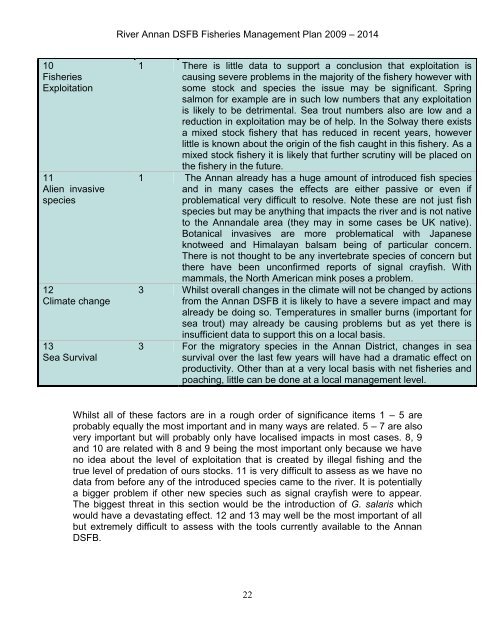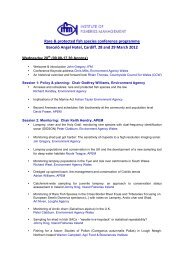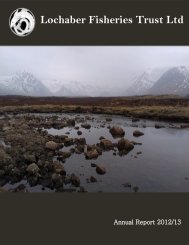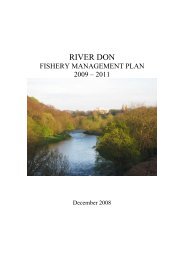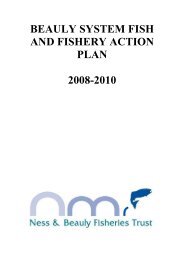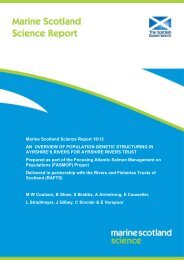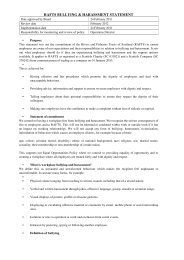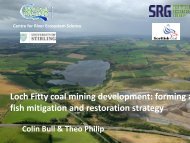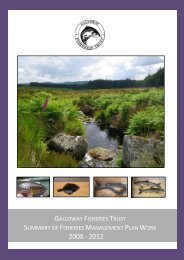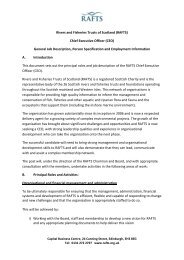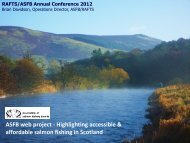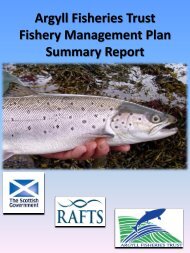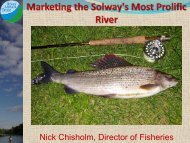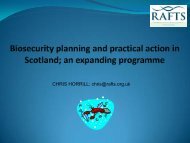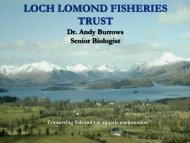Create successful ePaper yourself
Turn your PDF publications into a flip-book with our unique Google optimized e-Paper software.
River <strong>Annan</strong> DSFB Fisheries <strong>Management</strong> <strong>Plan</strong> 2009 – 201410FisheriesExploitation11Alien invasivespecies12Climate change13Sea Survival1 There is little data to support a conclusion that exploitation iscausing severe problems in the majority of the fishery however withsome stock and species the issue may be significant. Springsalmon for example are in such low numbers that any exploitationis likely to be detrimental. Sea trout numbers also are low and areduction in exploitation may be of help. In the Solway there existsa mixed stock fishery that has reduced in recent years, howeverlittle is known about the origin of the fish caught in this fishery. As amixed stock fishery it is likely that further scrutiny will be placed onthe fishery in the future.1 The <strong>Annan</strong> already has a huge amount of introduced fish speciesand in many cases the effects are either passive or even ifproblematical very difficult to resolve. Note these are not just fishspecies but may be anything that impacts the river and is not nativeto the <strong>Annan</strong>dale area (they may in some cases be UK native).Botanical invasives are more problematical with Japaneseknotweed and Himalayan balsam being of particular concern.There is not thought to be any invertebrate species of concern butthere have been unconfirmed reports of signal crayfish. Withmammals, the North American mink poses a problem.3 Whilst overall changes in the climate will not be changed by actionsfrom the <strong>Annan</strong> DSFB it is likely to have a severe impact and mayalready be doing so. Temperatures in smaller burns (important forsea trout) may already be causing problems but as yet there isinsufficient data to support this on a local basis.3 For the migratory species in the <strong>Annan</strong> District, changes in seasurvival over the last few years will have had a dramatic effect onproductivity. Other than at a very local basis with net fisheries andpoaching, little can be done at a local management level.Whilst all of these factors are in a rough order of significance items 1 – 5 areprobably equally the most important and in many ways are related. 5 – 7 are alsovery important but will probably only have localised impacts in most cases. 8, 9and 10 are related with 8 and 9 being the most important only because we haveno idea about the level of exploitation that is created by illegal fishing and thetrue level of predation of ours stocks. 11 is very difficult to assess as we have nodata from before any of the introduced species came to the river. It is potentiallya bigger problem if other new species such as signal crayfish were to appear.The biggest threat in this section would be the introduction of G. salaris whichwould have a devastating effect. 12 and 13 may well be the most important of allbut extremely difficult to assess with the tools currently available to the <strong>Annan</strong>DSFB.22


